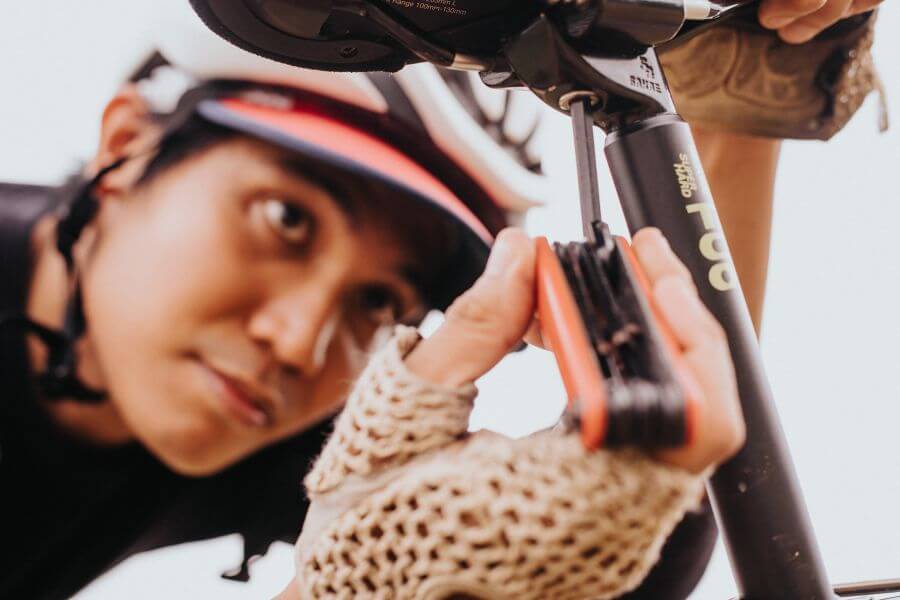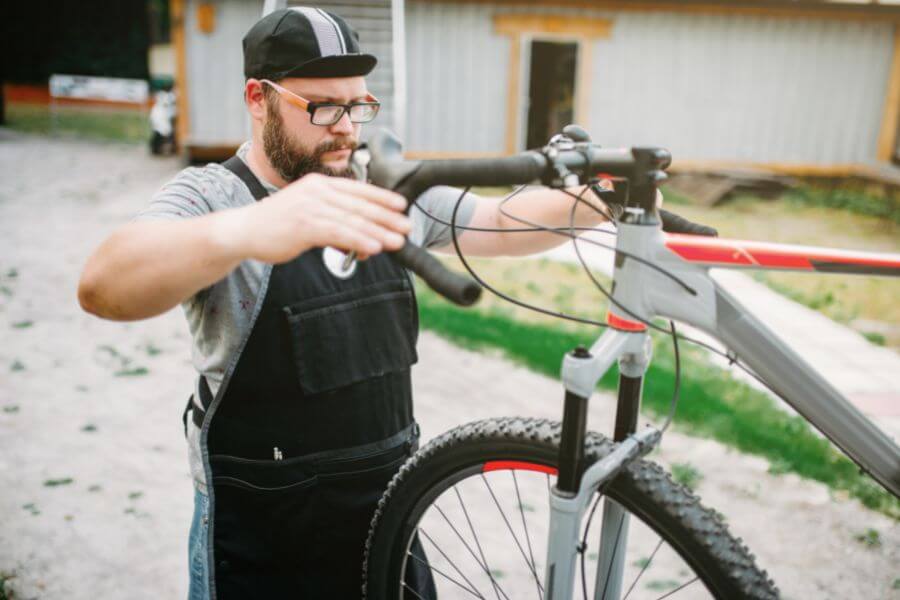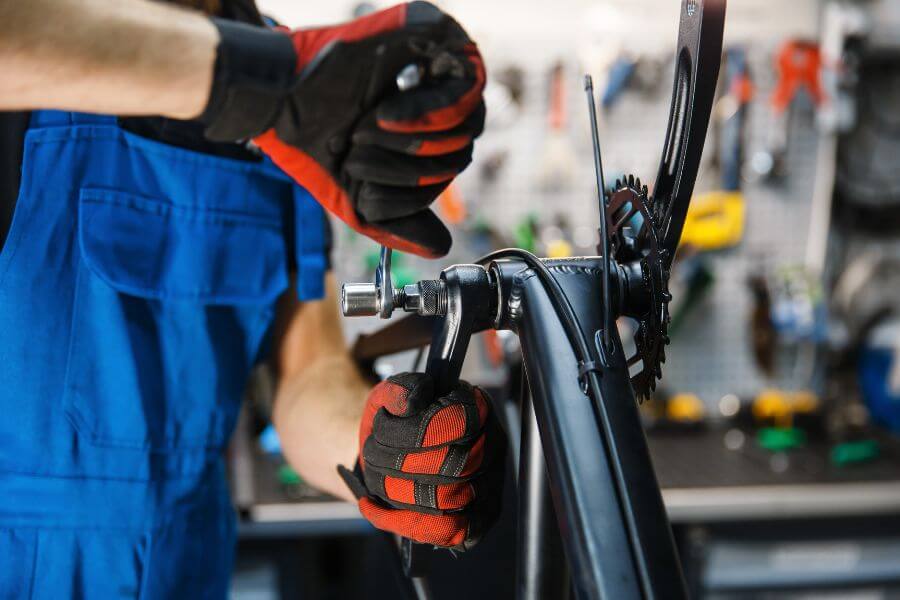As a cyclist, you know that your bicycle is more than a sports instrument or a means of transport. It is an extension of your body, a tool that allows you to overcome your limits and explore the world. But to truly enjoy the joys of cycling, you must make sure that your bicycle is properly adjusted to your body. A bad adjustment or an inadequate geometry entails an uncomfortable performance and, sometimes, injuries that are easily avoidable if everything is tailored. How much should you place the armchair? And the handlebar? What power length do you need? In this guide, we will show you how to achieve the perfect adjustment of your bicycle so you can pedal comfortably, efficiently and enjoying each pedal.
The first step to achieve proper bicycle adjustment is to understand
The basic principles of bicycle geometry. Bicycle geometry refers to the shape and size of the painting and its components, and plays a crucial role when determining the general bicycle adjustment. Some key factors to take into account when evaluating bicycle geometry are the following:
- The length of the upper tube: this is the horizontal distance between the armchair and directorate tube, and affects the cyclist's reach and posture. A longer upper tube will provide a more aggressive driving position, while a shorter upper tube will be more upright and comfortable. If you want to know more about this I recommend that you take a look at our article on The importance of stack and reach.
- The angle of the vertical tube: this is the angle that forms the tube that connects the pedalier with the armchair and the ground. It affects the position of the hips and the cyclist's pelvis on the bicycle. A more pronounced angle of the vertical tube will provide a more aggressive driving position, while a softer angle will be more upright and comfortable.
- The direction angle: This is the angle that forms the ground with the steering pipe. The pipe is the front of the box that connects the fork and the handlebar. It affects the handling and stability of the bicycle. A more pronounced steering angle will provide more nervous and agile handling, while a softer angle will make the bicycle driving more stable.
Once you have a basic understanding of bicycle geometry, the next step is to adjust it to adapt it to your body. This process implies a combination of modifications in the height of the armchair, the position of the armchair forward or to tas, the height of the handlebar and the length of the power. It is important to make these adjustments gradually and pay attention to how your body feels while pedaling.
Why it is important to adjust the armchair
[Captation id = "Attachment_9361" Align = "Alignnone" Width = "900"]

(Image: captureow)[/caption]
Have you ever felt pain in the legs or in the pelvic area while pedaling? Do you have trouble maintaining a comfortable posture during your bicycle routes? So your armchair is likely not adjusted correctly. Adjusting the armchair of your bicycle is essential to achieve optimal performance and avoid injuries. Once you have the right adjustment, you will feel how your body best suits the bicycle and you can pedal more easily and comfortably.
The armchair is one of the most important components when adjusting your bicycle. The ideal height of the armchair is one that allows you to pedal with a slight flexion in the knee when the pedal is at the bottom of the route. To adjust the height of the armchair you just have to loosen the shell clamp, climb or lower the armchair to the fallen height and press it again. But the really important thing is to know what is the optimal height to which you must place it. To do this, marry the leg length by the inner face, from the heel to the groin, and multiply that figure by 0.88. You have more information about this in our G
Uía to calculate the height to which you must adjust the armchair of your bicycle.
The next step is to adjust the position of the armchair horizontally, that is to say forward or backwards with respect to the axis of the beal. The ideal position is that which allows you to comfortably reach the pedals and maintain a neutral posture of the spine. To adjust the horizontal position of the armchair you must loosen the fastening screws and slide the rail rails to one side or the other.
Why it is important to adjust the handlebar
[Captation id = "Attachment_9362" Align = "Alignnone" Width = "900"]

(Image: nomadsoulphotos)[/caption]
The height of the handlebar is also a crucial appearance of the bicycle adjustment. Your position is essential to improve your performance and comfort while pedaling have you ever felt that your handlebar is not in the right position while pedaling? Do you feel uncomfortable or with pain in the dolls or shoulders after a long bicycle ride?
A poorly adjusted handlebar can cause fatigue in muscles and joints, which can lead to long -term injuries. In addition, it can also negatively affect pedaling efficiency and reduce speed and resistance. However, with
The correct adjustment of the handlebar, you can improve your posture and alignment, which will help you pedal more efficiently and comfortably.
In general, the handlebar must be at the same height or slightly lower than the armchair, to avoid neck and back problems. The distance from the handlebar to the armchair must be such that it allows you to reach the handles with ease and comfort without having to extend your arms.
Do not forget to adjust the power
A frequent error when adjusting the direction of a bicycle is to forget the power. The power is the piece that connects the handlebar with the painting and, although it is a very small piece, its length affects the distribution of weights of the front axle. In other words, the longer the power, the greater the weight that is exerted on the front wheel, thus favoring stability.
A longer power favors the control of the bicycle on the climbs, since it makes the bicycle less reactive and nervous. On the other hand, the shortest powers provide extra agility and safety in the descents. As for ergonomics, the longest powers force the cyclist to go more stretched, in a more aerodynamic position but also more forced. The short powers, on the other hand, favor comfort above the bicycle, since the cyclist will go with the most upright back. Everything is a matter of position and performance, depending on what you want to get and what values you must bet on a power of a longer or less length.
The connecting rods, the great forgotten
[Captation Id = "Attachment_9363" Align = "Alignnone" Width = "900"]

(Image: nomadsoulphotos)[/caption]
It carries longer or shorter connecting rods can mean the difference between having a more efficient or more inefficient pedal. But it is also cause of discomfort, problems in the cadence of pedaling and injuries. The connecting rods are the arms that connect the pedals to the picture and can be modified to achieve a better performance on your routes. But not everything is a matter of winning some more watts. An incorrect adjustment of connecting rods can cause problems in the posture and alignment of the legs and can lead to muscle injuries.
There are different connecting rod measures, usually from 160 mm to 185 mm. Do not hesitate to consult our
Guide to know what the ideal connecting length for you is.
Coves, wheel pressures and other adjustments
It is important to keep in mind that achieving the perfect bicycle adjustment is a process and may require several modifications over time as your body adapts to the bicycle. It is also important to make a professional bicycle adjustment every few years, since our driving size and position change over time.
In addition to the como mentioned above, other factors that can contribute to an ideal bicycle adjustment are:
The position of the coves
The coves connect the shoes with the pedals. You can modify its position so that the foot is more advanced or more delayed when exercising the pedal blow. An adequate position of the coves will allow an optimal power transfer and reduce the risk of injuries.
The width of the handlebar
We have spoken before the height of the handlebars, but you should not neglect its width. The handlebars have different measures depending on their distance between extremes. An adequate width of the handlebar will favor optimal control and comfort.
The pressure of the tires
The correct pressure of the wheels on your bicycle can make the difference between a comfortable and safe pedaling experience or an uncomfortable and unstable. Too high pressure can cause greater friction and wear in the tires, while too low pressure can cause stability problems and increase the risk of punctures.
Correctly adjust wheel pressure It will help you improve the efficiency in the pedaling, security and durability of your tires.
Conclusion
An adequate bicycle adjustment is essential for optimal performance and comfort on both the road and on the paths out of asphalt. The most advisable thing is to become a technical fitting or a biomechanical study. Do not limit yourself to place the height of the armchair and the handlebar. Other components such as the width of the handlebars, the length of the power, the connecting rods or the position of the coves on the pedals are also important to achieve the perfect adjustment and bring your experience as a cyclist to the next level. Ultimately remember that what it is about is not only to get the best performance on top of the bicycle, but to avoid physical problems and prevent injuries.
Nor do you forget that, although some accessories can be modified in length, position and angle to adapt to your measures, the most important thing is
Choose correct bicycle size.
 (Image: captureow)[/caption]
Have you ever felt pain in the legs or in the pelvic area while pedaling? Do you have trouble maintaining a comfortable posture during your bicycle routes? So your armchair is likely not adjusted correctly. Adjusting the armchair of your bicycle is essential to achieve optimal performance and avoid injuries. Once you have the right adjustment, you will feel how your body best suits the bicycle and you can pedal more easily and comfortably.
The armchair is one of the most important components when adjusting your bicycle. The ideal height of the armchair is one that allows you to pedal with a slight flexion in the knee when the pedal is at the bottom of the route. To adjust the height of the armchair you just have to loosen the shell clamp, climb or lower the armchair to the fallen height and press it again. But the really important thing is to know what is the optimal height to which you must place it. To do this, marry the leg length by the inner face, from the heel to the groin, and multiply that figure by 0.88. You have more information about this in our GUía to calculate the height to which you must adjust the armchair of your bicycle.
The next step is to adjust the position of the armchair horizontally, that is to say forward or backwards with respect to the axis of the beal. The ideal position is that which allows you to comfortably reach the pedals and maintain a neutral posture of the spine. To adjust the horizontal position of the armchair you must loosen the fastening screws and slide the rail rails to one side or the other.
(Image: captureow)[/caption]
Have you ever felt pain in the legs or in the pelvic area while pedaling? Do you have trouble maintaining a comfortable posture during your bicycle routes? So your armchair is likely not adjusted correctly. Adjusting the armchair of your bicycle is essential to achieve optimal performance and avoid injuries. Once you have the right adjustment, you will feel how your body best suits the bicycle and you can pedal more easily and comfortably.
The armchair is one of the most important components when adjusting your bicycle. The ideal height of the armchair is one that allows you to pedal with a slight flexion in the knee when the pedal is at the bottom of the route. To adjust the height of the armchair you just have to loosen the shell clamp, climb or lower the armchair to the fallen height and press it again. But the really important thing is to know what is the optimal height to which you must place it. To do this, marry the leg length by the inner face, from the heel to the groin, and multiply that figure by 0.88. You have more information about this in our GUía to calculate the height to which you must adjust the armchair of your bicycle.
The next step is to adjust the position of the armchair horizontally, that is to say forward or backwards with respect to the axis of the beal. The ideal position is that which allows you to comfortably reach the pedals and maintain a neutral posture of the spine. To adjust the horizontal position of the armchair you must loosen the fastening screws and slide the rail rails to one side or the other.
 (Image: nomadsoulphotos)[/caption]
The height of the handlebar is also a crucial appearance of the bicycle adjustment. Your position is essential to improve your performance and comfort while pedaling have you ever felt that your handlebar is not in the right position while pedaling? Do you feel uncomfortable or with pain in the dolls or shoulders after a long bicycle ride?
A poorly adjusted handlebar can cause fatigue in muscles and joints, which can lead to long -term injuries. In addition, it can also negatively affect pedaling efficiency and reduce speed and resistance. However, with The correct adjustment of the handlebar, you can improve your posture and alignment, which will help you pedal more efficiently and comfortably.
In general, the handlebar must be at the same height or slightly lower than the armchair, to avoid neck and back problems. The distance from the handlebar to the armchair must be such that it allows you to reach the handles with ease and comfort without having to extend your arms.
(Image: nomadsoulphotos)[/caption]
The height of the handlebar is also a crucial appearance of the bicycle adjustment. Your position is essential to improve your performance and comfort while pedaling have you ever felt that your handlebar is not in the right position while pedaling? Do you feel uncomfortable or with pain in the dolls or shoulders after a long bicycle ride?
A poorly adjusted handlebar can cause fatigue in muscles and joints, which can lead to long -term injuries. In addition, it can also negatively affect pedaling efficiency and reduce speed and resistance. However, with The correct adjustment of the handlebar, you can improve your posture and alignment, which will help you pedal more efficiently and comfortably.
In general, the handlebar must be at the same height or slightly lower than the armchair, to avoid neck and back problems. The distance from the handlebar to the armchair must be such that it allows you to reach the handles with ease and comfort without having to extend your arms.
 (Image: nomadsoulphotos)[/caption]
It carries longer or shorter connecting rods can mean the difference between having a more efficient or more inefficient pedal. But it is also cause of discomfort, problems in the cadence of pedaling and injuries. The connecting rods are the arms that connect the pedals to the picture and can be modified to achieve a better performance on your routes. But not everything is a matter of winning some more watts. An incorrect adjustment of connecting rods can cause problems in the posture and alignment of the legs and can lead to muscle injuries.
There are different connecting rod measures, usually from 160 mm to 185 mm. Do not hesitate to consult our Guide to know what the ideal connecting length for you is.
(Image: nomadsoulphotos)[/caption]
It carries longer or shorter connecting rods can mean the difference between having a more efficient or more inefficient pedal. But it is also cause of discomfort, problems in the cadence of pedaling and injuries. The connecting rods are the arms that connect the pedals to the picture and can be modified to achieve a better performance on your routes. But not everything is a matter of winning some more watts. An incorrect adjustment of connecting rods can cause problems in the posture and alignment of the legs and can lead to muscle injuries.
There are different connecting rod measures, usually from 160 mm to 185 mm. Do not hesitate to consult our Guide to know what the ideal connecting length for you is.












